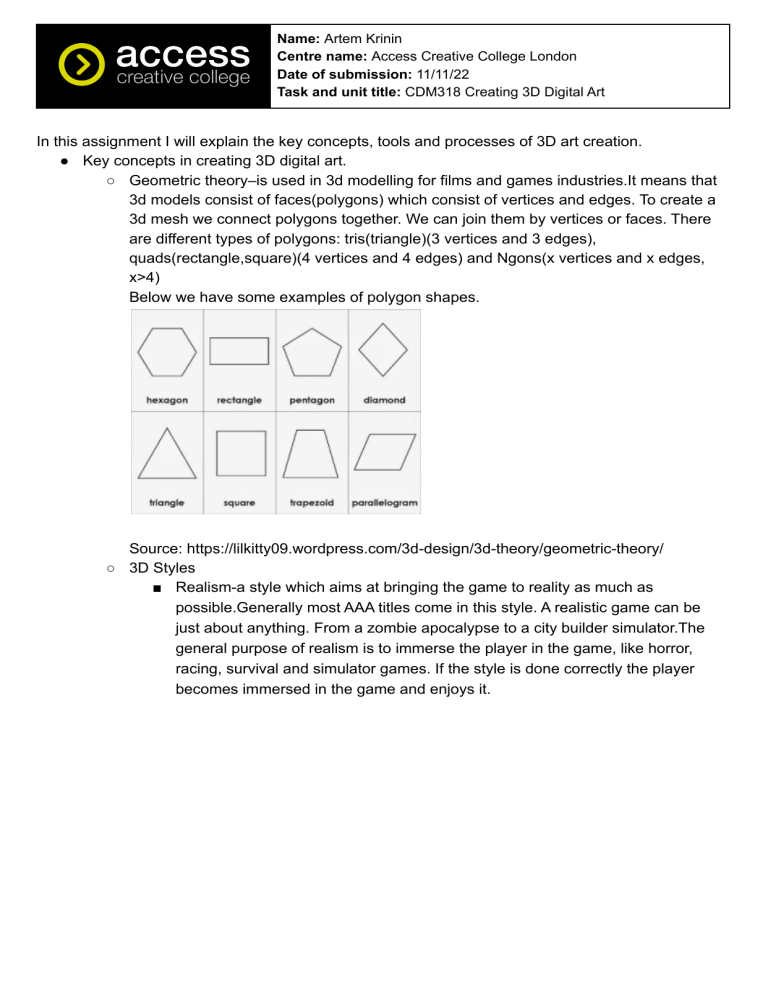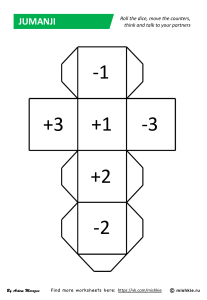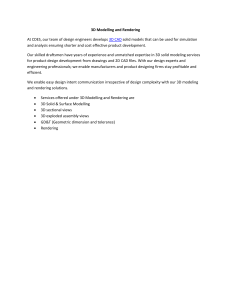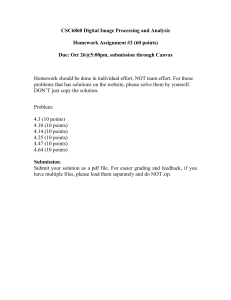
Name: Artem Krinin Centre name: Access Creative College London Date of submission: 11/11/22 Task and unit title: CDM318 Creating 3D Digital Art In this assignment I will explain the key concepts, tools and processes of 3D art creation. ● Key concepts in creating 3D digital art. ○ Geometric theory–is used in 3d modelling for films and games industries.It means that 3d models consist of faces(polygons) which consist of vertices and edges. To create a 3d mesh we connect polygons together. We can join them by vertices or faces. There are different types of polygons: tris(triangle)(3 vertices and 3 edges), quads(rectangle,square)(4 vertices and 4 edges) and Ngons(x vertices and x edges, x>4) Below we have some examples of polygon shapes. Source: https://lilkitty09.wordpress.com/3d-design/3d-theory/geometric-theory/ ○ 3D Styles ■ Realism-a style which aims at bringing the game to reality as much as possible.Generally most AAA titles come in this style. A realistic game can be just about anything. From a zombie apocalypse to a city builder simulator.The general purpose of realism is to immerse the player in the game, like horror, racing, survival and simulator games. If the style is done correctly the player becomes immersed in the game and enjoys it. Name: Artem Krinin Centre name: Access Creative College London Date of submission: 11/11/22 Task and unit title: CDM318 Creating 3D Digital Art Name: Artem Krinin Centre name: Access Creative College London Date of submission: 11/11/22 Task and unit title: CDM318 Creating 3D Digital Art ■ Fantasy Realism-a Realism which is not possible in real-life, genres such as fantasy, steampunk, sci-fi, etc. which is not possible in our real world right now. Is used in 3D games such as ARPGs(action role-playing games), shooters, etc. Because the style is not attached to real life it keeps people more interested because of having no restrictions at all. ■ Low Poly-this style has been in trend for a past couple of years.The illustrations in this style are composed of triangles. The difficulty of this style lies in the way it’s created, you have to manipulate every single triangle which makes it labour intensive.Usually anti-aliasing is not used so it makes every triangle visible, and a certain colour is assigned to each triangle. The main focus of this style is the forms and scene lighting. The name of it does not necessarily mean that the polygon count is low, often artworks in this style can exceed a million polygons.We usually see it mixed with other styles in games, it’s very focused on minimalism, but the complexity of the models varies, and by improvising artists get good visual combinations. The style can be used in any genre of a game, it’s used when the focus is more on the story and visuals and graphics are secondary. Name: Artem Krinin Centre name: Access Creative College London Date of submission: 11/11/22 Task and unit title: CDM318 Creating 3D Digital Art ■ ■ Hand-Painted-”This style is characterized by freehand texture painting.” Every small detail, shadow, texture, highlights are drawn on the actual geometry. Prominent examples of games that use this style are Dota and Warcraft. Mostly used in fantasy and strategy games. The style may be leaning towards comics, cartoons or sometimes even realism. Name: Artem Krinin Centre name: Access Creative College London Date of submission: 11/11/22 Task and unit title: CDM318 Creating 3D Digital Art ■ ■ Cartoon-includes low poly as well as hand-painted options, is also called casual.The textures for such graphic style may be hand-drawn or non-existent at all. New features are always brought to this art direction because of artists having their own style. There are a couple of most pronounced substyles: ● Voxel style–in simple words a pixel art but in 3D. Everything is composed of little cubes-voxel, and each one of them has a solid colour assigned to it. Sometimes a texture may be assigned to voxels, like in minecraft. ● Plasticine style–this style makes the art seem like it’s made out of plasticine. Plasticine Crow or Last year’s snow was falling are good examples of movies in this style. ● Mixed style–if we take LittleBigPlanet series of games as an example, we can see that the style is bound to multiple textures, with the emphasis on materials like wood, fabric, cardboard and more. Name: Artem Krinin Centre name: Access Creative College London Date of submission: 11/11/22 Task and unit title: CDM318 Creating 3D Digital Art ■ Source: https://kevurugames.com/blog/3d-art-styles-that-rule-the-game-world-application s-and-examples/ ○ The uses of 3D art:There are several industries that use 3D, some examples of them are: ■ Games–3d is used to create 3d assets and 3d scenes for use in game.For this process a 3d “editor” software is used(Autodesk Maya,Adobe Substance 3D Painter,ZBrush,Blender) and a game engine to bring everything together(Unreal Engine,Unity). Name: Artem Krinin Centre name: Access Creative College London Date of submission: 11/11/22 Task and unit title: CDM318 Creating 3D Digital Art ■ Film–3d is used to create 3d assets, visual effects and 3d scenes for use in films.For films there is also a compositing stage which is very important to combine the “real world” footage with 3d footage into one. The same software is used as in games. ■ Architecture–3d is used to create interior and exterior designs.The softwares usually used are AutoCAD, 3DS Max,Unreal Engine.Any software can be used Name: Artem Krinin Centre name: Access Creative College London Date of submission: 11/11/22 Task and unit title: CDM318 Creating 3D Digital Art for this, but these 3 are the most popular. ● The tools used for creating 3D digital art: ○ Autodesk Maya– is a 3D computer graphics application which is used in the development of video games, 3D applications, animated films, TV series, and any visual effects. This software can create heavy models, which helps to achieve Ultra 3D effects that create a realistic view for the user. Usually it is called “Maya”. The software can be used on all OS. ○ Adobe Substance 3D Painter–is one of the leading solutions for 3D texturing. It's a frequently used 3D texturing app for creative professionals and hobbyists with hundreds of smart materials at hand and a powerful brush engine that allows to texture any 3D model in just a couple of minutes. ○ Unreal Engine–is a game engine which contains creation tools for game development, architectural and automotive visualisation, linear film and television content creation, broadcast and live event production, training and simulation, and other real-time applications. ○ Arnold–”uses multiple diffuse and specular inter-reflection levels, so the light bounces off a wall or other objects to indirectly illuminate a character or object.”-https://academyofanimatedart.com/arnold-software/ . Popular cpu and recently added gpu renderer which is endorsed for it simplicity and quality. Comes with Maya and 3DS Max but can be purchesed for various other ○ Blender– One of the only free and open-source 3D creation suites that contains basically every 3D tool and is greatly enhanced with community created addons. Has a Name: Artem Krinin Centre name: Access Creative College London Date of submission: 11/11/22 Task and unit title: CDM318 Creating 3D Digital Art good foundation of modelling tools with wide texturing capabilities, rigging, skinning, animation, lighting, composting and even coding! ○ ZBrush–a digital sculpting software whose main feature is a workflow which is usually described as “sculpting clay” that combines 3D/2.5D modelling, texturing and painting. “It uses a proprietary "pixol" technology which stores lighting, color, material, orientation and depth information for the points making up all objects on the screen.” ○ 3DS Max–a professional 3D modelling and rendering software for architectural visualisation, games, and animation. The processes for creating 3D digital art ○ 3D modelling pipeline ■ Pre-production–The process which involves drawing the model from different angles, capturing the details and outlining the art style.it’s good to decide at this stage which materials will be used, how the UVs will be done, whether it will have fur and clothes, etc. ■ 3D Modelling–The process of manipulating the specific verts and polygons to achieve the desirable result.Usually the block out of the model is created by using the primitives(cube,sphere,cylinder,torus, etc.). ■ UV Mapping–the ability to unfold a model into a 2D plane to use as a 2D image.This allows you to apply colour and texture to specific parts of the model in a certain way. When a UV map is applied it stitches back onto the modes ■ ■ ■ ■ automatically connecting the UV islands. Texturing–after the UV map has been created comes texturing.Various softwares can be used for this but the most popular ones are PBR(physically based rendering) based which are common practice in film and games industries.By using PBR the model turns out more realistic and detailed due to the use of normal maps. Rigging–a process of inserting so-called “bones” into the models to simplify the animation process. Is usually done for organic models like characters and creatures. Animation–is done after the model has been rigged because the engine needs the skeleton to animate the model and simply the movement process.It is done before the lighting as lighting slows down the viewport and doesn’t impact the animation. Lighting–impacts the model and its textures, that’s why it comes after these processes. Can be baked for faster performance but cannot be changed after. Name: Artem Krinin Centre name: Access Creative College London Date of submission: 11/11/22 Task and unit title: CDM318 Creating 3D Digital Art ● ■ Rendering–is the second last step, but also one of the most satisfying ones.It is done at the end because it takes quite a lot of time to get a good render. ■ Compositing–while compositing and rendering are technically different they complement each other and for the final stage of the pipeline. Final image that is shown is where the compositing is applied to push the render even further and make it look significantly better by using colour correction and other techniques. ■ Source:https://medium.com/@homicidalnacho/3d-modelling-pipeline-bd9be7dba 136 ○ Rendering techniques: ■ Scanline Rendering Technique–When it is needed to reduce the time it takes to render something the scanline technique comes in hand.Instead of rendering pixel by pixel it uses real-time polygon by polygon rendering which makes possible achieving 60 frames per second speed of rendering, when it’s used together with baked(precomputed) lighting. ■ Ray Tracing Rendering Technique–traces the natural light rays by precise “bounces” through refraction or reflection of the various materials in the 3D scene.It’s advantages are algorithmical colour computation and the best photorealism results. But the only downside to it is that it’s extremely slow, and much slower than the scanline. ■ Ray Casting Rendering Technique–When working on a project that doesn’t require to show many details, the ray casting technique is your best choice. Its primary use is real-time simulations of 3D modelling. It renders a scene using the geometry of the object line by line and pixel by pixel. Achieving a better performance in the computational stage gives better results. Source:https://www.bluentcad.com/blog/best-3d-rendering-techniques/ A range of industries which utilise 3D digital technologies: Name: Artem Krinin Centre name: Access Creative College London Date of submission: 11/11/22 Task and unit title: CDM318 Creating 3D Digital Art ○ Medicine–the 3D is used there to print artificial parts of the body to replace them in humans like prosthesis. ○ Games–3D is used in games to create graphics and assets. Name: Artem Krinin Centre name: Access Creative College London Date of submission: 11/11/22 Task and unit title: CDM318 Creating 3D Digital Art ○ Advertisements–3D is widely used in this industry to create short or long adverts promoting the product or the brand, motion graphics are mostly used in this industry. ○ Architecture–in this industry 3D is used to recreate interiors and exteriors of projects to demonstrate it to investors or buyers.


